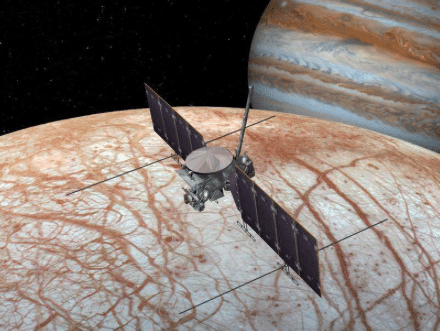
The Department of Earth, Planetary, and Space Science (EPSS) at UCLA has an impressive record of leadership or participation in NASA missions. For example, the Galileo mission explored Jupiter and its moons between 1995 and 2003. EPSS Professor Margaret G. Kivelson was the Principal Investigator of the Galileo magnetometer instrument.
Using magnetometer measurements, Prof. Kivelson and her team provided strong evidence for the existence of a subsurface ocean beneath Europa’s icy shell. This discovery is far-reaching because the presence of a liquid water environment opens the possibility that on one of Jupiter’s moons may harbor life. Since then, scientists have been chasing additional evidence to characterize Europa’s environment, either through space- or ground-based observations.
With support from Congress, NASA has approved the development of the Europa Clipper mission, a multiple-flyby mission that will characterize Europa and investigate its habitability. One of the main objectives of the mission is to confirm the presence or absence of a global subsurface ocean beneath Europa’s icy crust. EPSS scientist Dr. Ashok Kumar Verma and Prof. Jean-Luc Margot performed comprehensive sets of gravity science simulations using the anticipated trajectory of NASA’s Europa Clipper mission to quantify whether gravity science measurements can be obtained with sufficient precision to address the hypothesis that Icy satellite Europa has a global subsurface ocean?

Figure 1: Europa Clipper Mission (image credit: NASA/JPL-Caltech)
Gravity science experiments provide powerful data for investigating the physical state of planetary bodies, including mapping the gravity field, estimating the rotational state, and probing the internal structure of a planet or satellite. These experiments rely primarily on two-way Doppler shift measurements between spacecraft and Earth-based antennas, which yield the velocity of the spacecraft along the observer’s line-of-sight. Because the gravitational field affects the spacecraft velocity, radio tracking of spacecraft can yield a detailed description of the gravity field. At Europa, the gravity field varies with time because of the strong tides induced by Jupiter. The tidal amplitude is expected to be as large as 30 m (100 ft) if there is a global ocean, and much smaller otherwise.
To achieve science goals of the mission, Clipper trajectories are designed to obtain globally distributed regional coverage of Europa with multiple low-altitude flybys. The Europa Clipper will orbit Jupiter and execute repeated close flybys of Europa, Ganymede, and Callisto with science observations at Europa and gravitational assists at Ganymede and Callisto. However, an important consideration for a gravity science investigation is the distribution of sub-spacecraft latitudes when the spacecraft is at closest approach. The current trajectory provides an adequate distribution (see Figure 2) for gravity science purposes with the closest approach altitude as low as 25 km from Europa surface.
A Europa Clipper gravity science investigations can address important mission objectives, such as confirming the presence of an ocean, determining Europa’s gravity field, quantifying the time-varying tidal potential, verifying whether the ice shell is hydrostatic, and providing high-precision reconstructed trajectories that other instrument teams will greatly benefit from.
EPSS scientists tried to quantify the precision with which Europa’s geophysical parameters can be determined with the Europa Clipper mission. Their work suggests that, if adequate ground assets are used to track the Clipper spacecraft, the gravity measurements should be able to confirm if there is a global subsurface ocean and if the ice shell is hydrostatic. Confirming the existence of a global ocean on Europa will have a profound impact on the search for life in the Solar System.
These findings are described in the article entitled Expected precision of Europa Clipper gravity measurements, recently published in the journal Icarus. This work was conducted by Ashok Kumar Verma and Jean-Luc Margot from the University of California, Los Angeles (UCLA).









